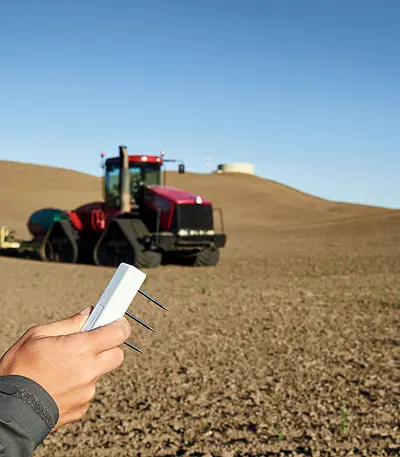Are biodegradable mulches actually better for the environment?

As a PhD student at Washington State University (WSU), Dr. Henry Sintim investigated whether biodegradable mulches are, in fact, what they claim to be. He and his research team wanted to understand what leaches into the soil as the mulches degrade and which ones performed as well as polyethylene (PE) plastic mulches at weed, pest, and disease control.
PLASTIC MULCH
Application of plastic mulches in agriculture is a common practice by specialty crop producers worldwide. It conserves water, and helps in weed, pest, and disease control, subsequently improving crop yield and quality. Because PE is durable and does not degrade in the soil, you cannot leave it in the field, which ultimately leads to the question of disposal. When PE is buried in the field, it becomes contaminated with soil and can’t be recycled. Disposing of it requires growers to transport it to a landfill—if landfill facilities are available at all—increasing costs. When landfills are not an option, growers stockpile PE on their farm, where the rain can wash the mulch down to streams and water bodies. Dr. Henry Sintim and his team investigated whether or not biodegradable plastic mulches (BDMs) could be a viable alternative.
BIODEGRADABLE ALTERNATIVES
Substituting PE with BDM could alleviate the need for disposal. However, Dr. Sintim says the potential impact on agricultural soil ecosystems needs to be assessed before adopting biodegradable mulch for field use. For instance, do biodegradable mulches really degrade? Dr. Sintim explains, “By BDM, we mean it is plastic mulch, but it has been made from pure or partial biobased materials. Though there are plastic mulches advertised as biodegradable, none have actually been proven to biodegrade, so the team is examining degradation of different commercial BDM types over time. They have also included an experimental BDM, in which the constituents were specified by the team.”
Dr. Sintim monitored the degradation of BDM by assessing the material properties and measuring the particle size and surface area via photography: digitizing and analyzing them using Image J software.

HOW WELL DO THE MULCHES COMPARE?
Dr. Sintim also wants to find out how well BDMs maintain microclimate in comparison to PE. Since soil temperature and moisture content are important parameters that govern chemical reaction rates and microbial activity, and are likely to vary among the different BDM treatments, he monitored soil moisture dynamics using METER soil moisture and temperature sensors installed at 10 cm and 20 cm depths. In addition, the team installed sensors directly underneath the mulches to measure surface temperature and light penetration. Reduction of light penetration is the attribute that helps plastic mulches to control weeds. The team also assessed soil quality using the USDA Soil Quality Test Kit.
Dr. Sintim says so far one of the commercial BDMs and the experimental BDM had the same yield performance as PE. He adds, “We don’t have final results yet, and there are a lot of variables that could come into the picture. But I will say there is an indication that some of the BDMs are performing well.”
LEACHING
Dr. Sintim and his team wanted to understand what’s leaching through the soil as the mulches degrade. He installed METER G3 passive capillary lysimeters at a 55 cm depth to collect leachate samples for analysis of BDM particulates. He was surprised when the lysimeter readings revealed higher EC measurements. However, the EC in the PE, paper mulch, and no-mulch treatments were also high, hence that could be due to the leaching of accumulated salts in the soil surface. He says, “We have yet to examine the leachate samples for the presence of particulates.”
COMPOSTING ALTERNATIVES
If the team finds that some of the BDMs do not biodegrade very well in the field, the alternative could be on-farm composting, which would be more viable than having to deal with polyethylene plastic. Dr. Sintim and his research team set up a composting study where they digitized the images of the mulches degrading. He adds, “We buried the mulches in a mesh bag, and periodically we retrieve the bags to study the mulch. There was some black staining on the mesh bag, which we suspect is a nanoparticle called, “carbon black,” used as reinforcing filler in tires and other rubber products.
Because manufacturers do not disclose the actual constituents of their mulches, Dr. Sintim arranged to examine the mesh bags with WSU’s scanning electron microscope in order to confirm that the stains were due to the presence of particulates. Dr. Sintim confirmed that carbon black was used in their experimental BDM, but they don’t know whether the carbon black was made from petroleum products, as there is non-petroleum-based carbon black. He is going to determine whether these particles leach through soil by examining leachate samples from the lysimeter. He will also perform more tests to make sure that these nanoparticles are not going to have any adverse effects on the agro-ecosystem.
WHAT’S IN THE FUTURE?
While Dr. Sintim and his colleagues have made important discoveries, there is still work to be done. He and his team continued to collect data to see if there really is a BDM that delivers on its promises and if leaching particles pose a threat to the groundwater.
Explore METER soil moisture sensors and the G3 lysimeter.
Learn more about Dr. Sintim’s continuing research at the H. Sintim Lab

Case studies, webinars, and articles you’ll love
Receive the latest content on a regular basis.